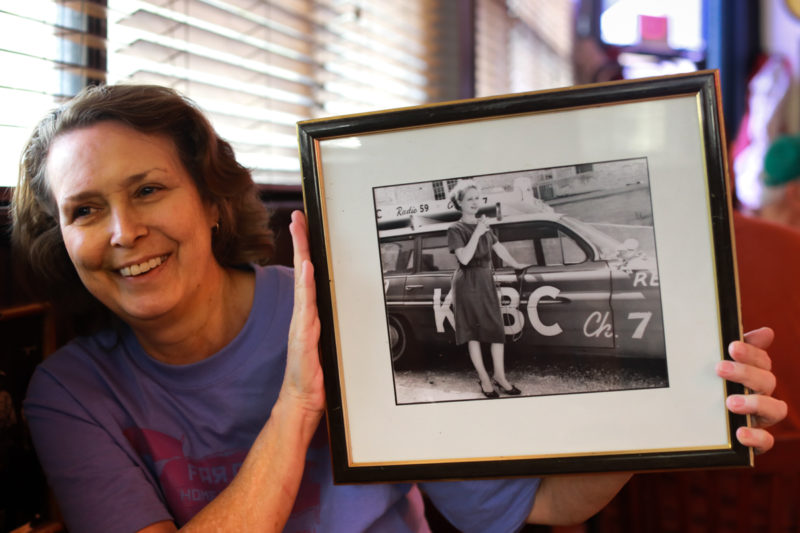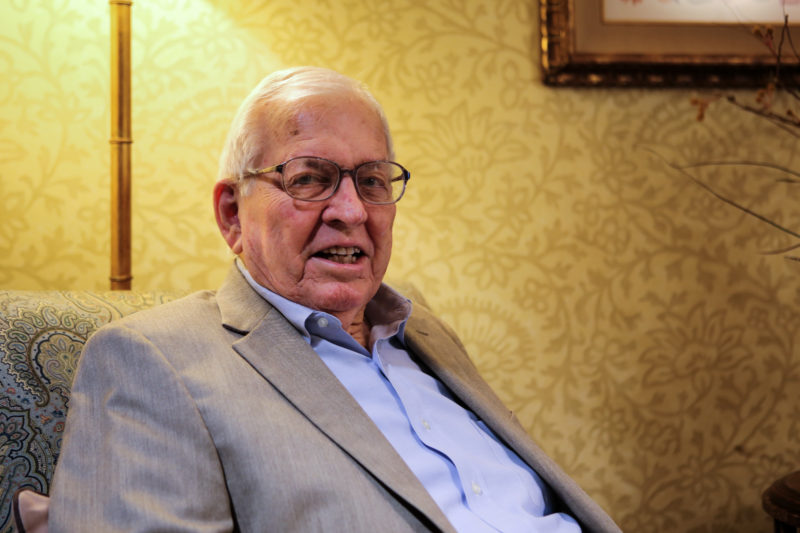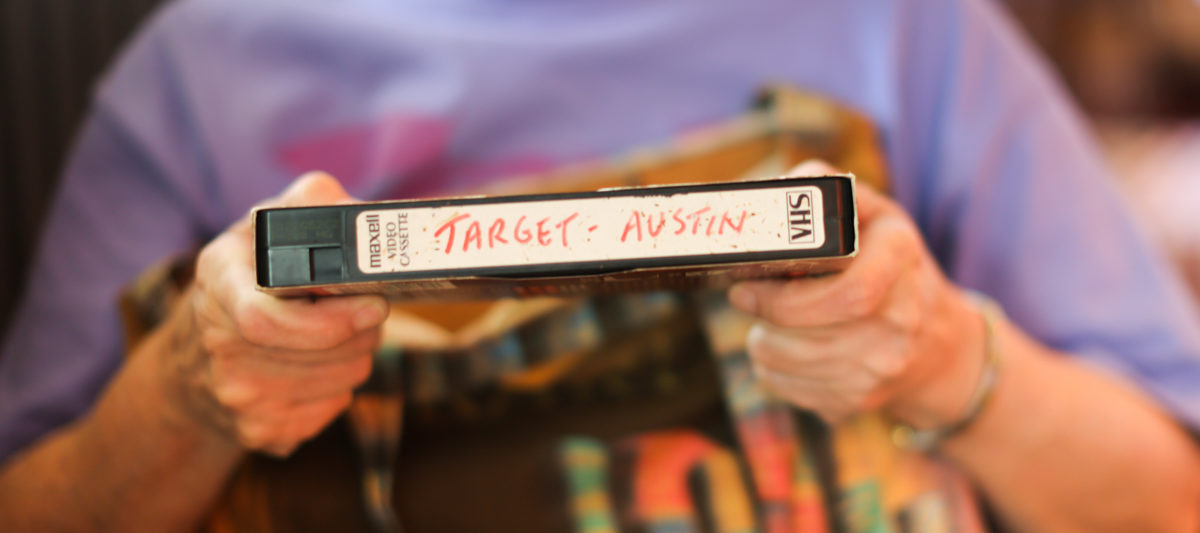The Time When Austin Learned to Start Worrying and Fear the Bomb
By Louise Rodriguez
Reporting Texas

Beverly Robinson’s mother, Barbara, was a KTBC-TV newscaster who played a role in a 1960 film the station made about the threat of a nuclear attack by Russia. Yi Li/Reporting Texas
It’s a clear June day in Austin. A housewife and her little girl hang laundry outside, students at the University of Texas at Austin attend summer classes and all seems well.
Then an urgent warning comes over the radio: Russian missiles have been detected over Canada —and one is headed straight for the capital of Texas!
It was 1960, and Cold War tensions were rising between the U.S. and Russia, along with the fear of a nuclear attack. While most Americans relied on advice from the federal Office of Civil Defense on preparing for a possible attack, some prominent Austinites at KTBC-TV produced their own public information film, “Target… Austin, Texas.”
The film was narrated by KTBC broadcaster Cactus Pryor and featured El Rancho restaurant owner Matt Martinez as himself. KTBC anchor Barbara Robinson had the most dramatic role in the film, which now resides in the Texas Archive of the Moving Image.
Austin was then a city of about 186,000. And as home to Bergstrom Air Force Base’s Strategic and Tactical Air Commands, it was a potential target. Soviet Premier Nikita Khrushchev had boasted that his country’s missiles were capable of reaching the U.S. Schoolchildren were learning to duck and cover beneath their desks in the event of a nuclear blast, communities regularly tested their air-raid sirens, and some people even built underground bomb shelters in their backyards.
The film has eerie echoes six decades later, as North Korea conducts nuclear missile tests and its leader Kim Jong Un and U.S. President Donald Trump trade increasingly antagonistic rhetoric. The world is once again on edge over the possibility of a nuclear attack.
“I’m surprised that there hasn’t been a little more interest in the whole matter,” said Terrell Blodgett, 94, who appeared in the film in his capacity as Austin’s civil defense manager, part of his job as an assistant city manager. “I’m not a big fan of the president, and I wake up every morning expecting to tune in to CNN and either North Korea or the U.S. has dropped the bomb.”

Terrell Blodgett, now 94 years old, was an assistant city manager and civil defense director who also appeared in the film. Yi Li/Reporting Texas
“It was serious business at the time,” Blodgett said. He used federal civil defense money to build a prototype fallout shelter in Zilker Park, . The shelter is still there today but is not open to the public.
Blodgett’s voice is among the first to be heard in “Target… Austin.” Using the emergency broadcasting system from the situation room in city hall’s basement, he alerts the public in a Lyndon Baines Johnson-like drawl: “This is your Austin civil defense manager with an urgent message. An air raid warning has been declared in this area.” KTBC anchor Barbara Robinson plays Carolyn Gilbert, an employee who grudgingly retreats to the basement of the downtown office building where she works, believing it’s just another drill.
Robinson’s daughter Beverly Robinson, 61, found a copy of the full-length version of “Target… Austin” five years ago, after the Austin American-Statesman ran a story about it. It was stored with other movies in the broiler compartment of her oven – her solution to a lack of storage space in her tiny apartment. She had no idea that her mom had been in film and later donated it to TAMI, which had only a clip.
During an interview with Reporting Texas, she holds up a slightly soiled VHS tape with “Target Austin” written on one side. At first, Beverly assumed the video was related to Target stores because her mother was known to write commercials. “I popped it in my machine and went, ‘Oh, God,’” she said.

Before watching it, Beverly Robinson thought the Target: Austin tape was a commercial for the retail chain. Yi Li/ Reporting Texas
In the film, the UT Tower is the last image seen before a nuclear explosion happens just west of Austin. Wagner’s “Ride of the Valkyries” begins its crescendo as dramatic scenes unfold: A family embracing each other in their home shelter, then Robinson as Gilbert clutching her face with her hands and screaming in terror – a scene used for one of the stills from the film.
Beverly’s brother, Kevin “Woody” Robinson, now 63, first saw the film in the 1960s, when his Austin High School health class covered how to stay safe during a nuclear event. He was mortified.
“They showed that movie with my mother doing the scream, the bombs are dropping,” said Kevin, now a teacher and basketball and golf coach at Austin High. “We’re all watching and my friends go, ‘Look! It’s Woody’s mother.’ I had no idea that movie was made until that moment. The shame came on me.”
“Target… Austin” is not the only locally produced film of its kind, according to Laura McEnaney, professor of history at Whittier College and author of “Civil Defense Begins at Home,” a book that explores how citizens and elected officials during the post-World War II era responded to Federal Civil Defense Administration instructions on how to prepare for a nuclear attack.
For example, McEnaney mentions “Reds Take Over Wisconsin,” based on a mock Communist takeover of the small town of Mosinee. She calls such films “nuclear-era morality tales.”
“You need to follow the rules, listen to the authorities, trust their advice, and if you don’t,” said McEnaney, “punishment will be exacted on you.”
Both Beverly and her mother, who passed away in 2002, worked as actors at times in their lives, Beverly at Esther’s Follies and in New York and her mother in local movies. At the height of the Cold War era, Beverly remembers seeing food stockpiled high up in a kitchen cabinet and her mother leading home drills.
“She’d have us go sit along a wall—we had a long hallway in our house in Tarrytown—and shut all the doors and put blankets and towels in along the cracks,” Beverly said. “We’d sit there with the food, and of course, Mother had the beer.”
But Beverly said her mom was a realist and ultimately acknowledged, as did most Americans, the futility of such drills. “Everybody knew that ‘duck and cover’ meant bend over, stick your head between your… and kiss your ass goodbye,” Beverly said.
The idea that everybody lived in a constant state of panic during the Cold War is an exaggeration, McEnaney said. “In fact, people behaved in ways that were more about rejecting that militarization of their private space,” she said.
In the film, Robinson’s character, hiding in the shelter, complains about the drills and weekly siren tests being a waste of time. Pryor, the narrator, sums up her thoughts: “Grown men playing war.”
“Target… Austin, Texas” ends with Robinson as Gilbert saying a prayer, apparently grateful for having survived the attack. Then comes a long shot of the Austin skyline and a nearly empty highway.